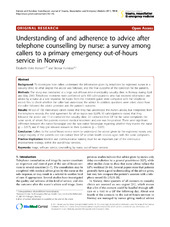| dc.contributor.author | Hansen, Elisabeth Holm | en_US |
| dc.contributor.author | Hunskår, Steinar | en_US |
| dc.date.accessioned | 2012-01-10T08:24:52Z | |
| dc.date.available | 2012-01-10T08:24:52Z | |
| dc.date.issued | 2011-09-05 | eng |
| dc.Published | Scandinavian Journal of Trauma, Resuscitation and Emergency Medicine 2011, 19:48 | en |
| dc.identifier.issn | 1757-7241 | |
| dc.identifier.uri | https://hdl.handle.net/1956/5385 | |
| dc.description.abstract | Background: To investigate how callers understand the information given by telephone by registered nurses in a casualty clinic, to what degree the advice was followed, and the final outcome of the condition for the patients. Methods: The study was conducted at a large out-of-hours intermunicipality casualty clinic in Norway during April and May 2010. Telephone interviews were performed with 100 callers/patients who had received information and advice by a nurse as a sole response. Six topics from the interview guide were compared with the telephone record files to check whether the caller had understood the advice. In addition, questions were asked about how the caller followed the advice provided and the patient’s outcome. Results: 99 out of 100 interviewed callers stated that they had understood the nurse’s advice, but interpreted from the telephone records, the total agreement for all six topics was 82.6%. 93 callers/patients stated that they followed the advice and 11 re-contacted the casualty clinic. 22 contacted their GP for the same complaints the same week, of whom five patients received medical treatment and one was hospitalised. There were significant difference between the native-Norwegian and the non-native Norwegian regarding whether they trusted the nurse (p=0.017), and if they got relevant answers to their questions (p=0.005). Conclusion: Callers to the out-of-hours service seem to understand the advice given by the registered nurses, and a large majority of the patients did not contact their GP or other health services again with the same complaints. Practice Implication: Medical and communicative training must be an important part of the continuous improvement strategy within the out-ofhour services. | en_US |
| dc.language.iso | eng | eng |
| dc.publisher | BioMed Central | eng |
| dc.relation.ispartof | <a href="http://hdl.handle.net/1956/5387" target="blank">Monitoring activities in out-of-hours emergency primary care in Norway. A special emphasis on nurses telephone triage and counselling</a> | eng |
| dc.rights | Attribution CC BY | eng |
| dc.rights.uri | http://creativecommons.org/licenses/by/2.0/ | eng |
| dc.title | Understanding of and adherence to advice after telephone counselling by nurse: A survey among callers to a primary emergency out-of-hours service in Norway | en_US |
| dc.type | Peer reviewed | |
| dc.type | Journal article | |
| dc.description.version | publishedVersion | en_US |
| dc.rights.holder | Copyright 2011 Hansen and Hunskaar; licensee BioMed Central Ltd. | |
| dc.identifier.doi | https://doi.org/10.1186/1757-7241-19-48 | |
| dc.identifier.cristin | 916777 | |
| dc.subject.nsi | VDP::Medical disciplines: 700::Health sciences: 800 | eng |
| dc.subject.nsi | VDP::Medical disciplines: 700::Health sciences: 800::Health service and health administration research: 806 | eng |

